
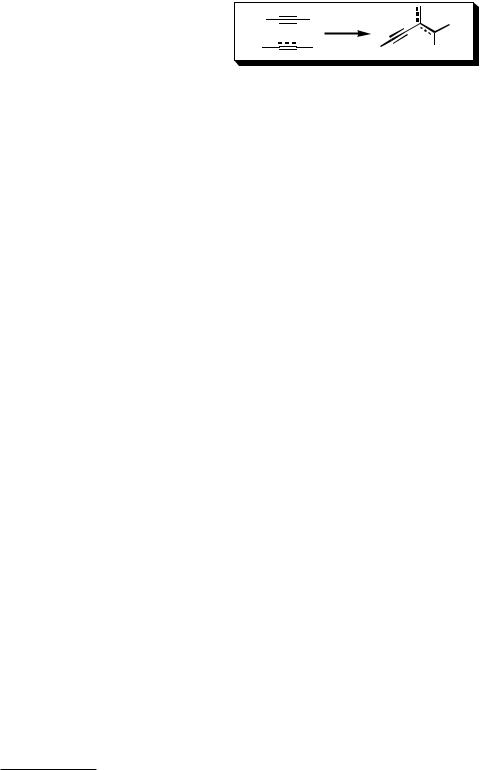
IV.5 Alkynyl Substitution via Alkynylpalladation–Reductive Elimination
VLADIMIR GEVORGYAN
A. INTRODUCTION
In this section, Pd-catalyzed homocoupling of terminal alkynes, cross-coupling of terminal alkynes with internal alkynes, and cross-coupling of terminal alkynes with allenes will be discussed. All three types of reactions involve (i) activation of the C—H bond of a terminal alkyne, (ii) alkynylpalladation of another molecule of alkyne or allene, and (iii) reductive elimination or protonation to produce a conjugated enyne. For alkynylpalladations of allenes followed by trapping with nucleophiles, see Sect. IV.7.
B. ALKYNYLPALLADATION OF ALKYNES FOLLOWED BY REDUCTIVE ELIMINATION
Trost and co-workers found that the Pd(OAc)2 tris(2,6-dimethoxyphenyl)phosphine (TDMPP) system catalyzes the homodimerization of terminal alkynes 1 to produce conjugated enynes 2 (Scheme 1).[1]–[5] This method is very simple and efficient: reactions are normally run in toluene or benzene at room temperature, and 2 mol % of the Pd catalyst is usually enough for complete conversion of 1 into enyne 2 in good to very good yields. The perfect regiocontrol is a remarkable feature of this reaction: coupling follows the sense of a Markovnikov-type addition leading to a head-to-tail dimer 2. The stereochemistry of addition is presumably syn, although it was not established for the homocoupling protocol. This reaction is efficient for the dimerization of alkyl-, aryl-, hetaryl-, and other terminal alkynes. Various types of functional groups in the side chain are compatible with these conditions. Yet, terminal alkynes containing an electron-withdrawing group adjacent to the triple bond (e.g., propiolates) cannot be employed in this reaction due to the exceptionally high acidity of the acetylenic hydrogen, which causes these compounds to undergo rapid polymerization.[4]
Further development of this reaction mode by Trost and co-workers led to the discovery of the alkyne–alkyne cross-coupling protocol. It was shown that addition of a terminal
Handbook of Organopalladium Chemistry for Organic Synthesis, Edited by Ei-ichi Negishi ISBN 0-471-31506-0 © 2002 John Wiley & Sons, Inc.
1463
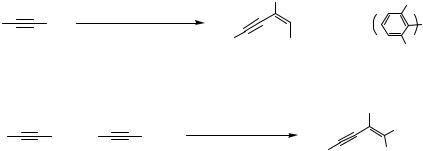
1464 |
IV Pd-CATALYZED REACTIONS INVOLVING CARBOPALLADATION |
alkyne (donor alkyne) to an internal Michael acceptor-type alkyne 3 (acceptor alkyne) in the presence of the same catalyst system [Pd(OAc)2 TDMPP] leads to the exclusive formation of a cross-dimer 4 (Scheme 2); thus the homocoupling route is completely discriminated. Several types of acceptor alkynes with electron-withdrawing substituents, 3, such as ester-, ketocarbonyl-, and sulfonyl groups, have successfully been employed in the selective cross-coupling reaction (Scheme 2).[4] The cross-coupling of 1 with 3 is also a perfectly regioand stereocontrolled process: the addition always occurs with syn stereochemistry and follows the regiochemical trend of a Michael addition leading to a single regioand stereoisomer 4 (Scheme 2). Trost and co-workers reported that Pd(0) complexes also catalyze the reductive coupling of alkynes. However, reactions in these cases were very sluggish and often incomplete.[4]
|
|
|
R1 |
OMe |
|
|
|
|
|
R1 |
H |
Pd(OAc)2 TDMPP (1:1) |
TDMPP = |
P |
|
||||
|
|
R1 |
|
3 |
|
1 |
H |
|
|
|
2 |
OMe |
||
|
|
Scheme 1
|
|
|
|
R2 |
R1 |
H + R2 |
Pd(OAc)2 TDMPP |
|
EWG |
EWG |
R1 |
|
||
1 |
|
3 |
H |
|
|
|
|
|
4 |
R1 = alkyl-, aryl-, TMS; R2 = Me, Ph; EWG = CO2Me, SO2Ph, COMe.
Scheme 2
Extension of this alkyne coupling methodology to intramolecular cases allowed the construction of medium to large ring systems 6 with varying degrees of efficiency (Scheme 3).[6] Again, as it was observed in the intermolecular mode of the reaction, the homocoupling of terminal alkynes 5 (R H) proceeded with Markovnikov-type regiochemistry, and cross-coupling (R EWG) followed the Michael-type addition motif leading to the n-exo-dig-cyclization products 6 (Scheme 3). However, cyclization of the diyne 7 with an electron-withdrawing group in the tether and adjacent to the internal triple bond of the acceptor alkyne follows the Michael-type regiochemical trend of addition leading to the endo-dig cyclization product 8 (Scheme 4).[6]
Two alternative mechanisms have been proposed by Trost and co-workers for the Pd(OAc)2 TDMPP-catalyzed reductive coupling of alkynes (Scheme 5).[4] In both mechanisms a Pd( 2)–Pd( 4)–(Pd 2) redox cycle is proposed. According to the first proposal ( A in Scheme 5, solid arrows), the terminal alkyne 1 coordinates to a Pd(OAc)2 TDMPP complex to form 9. Oxidative addition would lead to the Pd( 4) species 10, which, after elimination of acetic acid, would produce the acetoxypalladium acetylide 11. Coordination of the acceptor alkyne to 11 (intermediate 12), followed by migratory insertion, would form the alkenylpalladium species 13. Acetic acid would protiodepalladate 13 to give the coupling product 14 and regenerate the catalyst (Scheme 5, Mechanism A ). Two points distinguish this mechanism from the alternative Mechanism
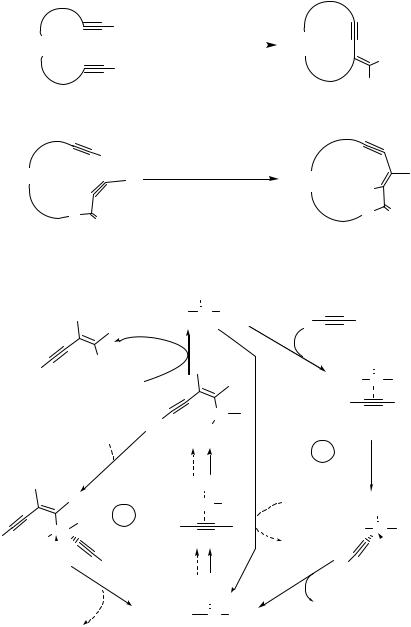
IV.5 ALKYNYL SUBSTITUTION VIA ALKYNYLPALLADATION |
1465 |
H
(CH2)n
R
5
H
(CH2 )11
O O
7
H
R
14 HOAc
1
|
H |
B |
R |
Pd |
|
AcO |
|
|
|
L |
|
15 |
|
R |
14
Pd(OAc)2 (10 mol %)
TDMPP (20 mol %)
|
|
(CH2)n |
|
16−70% |
|||
H |
|||
R = H or CO Et, n = 7−23 |
6 R |
||
2 |
|
|
|
Scheme 3 |
|
||
Pd(OAc)2 TDMPP
38%
Scheme 4
L
AcO Pd OAc
Pd L
R
AcO
13
L
R Pd OAc
Pd OAc
12
L
R Pd OAc
Pd OAc
11
Scheme 5
(CH2 )11 H
O O
8
R |
H |
|
|
|
1 |
|
|
|
|
L |
|
|
AcO |
Pd |
OAc |
|
R |
|
H |
|
|
|
9 |
|
A |
|
|
1 |
|
L |
|
|
|
|
|
|
AcO |
Pd |
OAc |
HOAc |
|
H |
|
|
R |
10 |
|
HOAc
B (dashed arrows in the Scheme 5): (i) the acetoxypalladium acetylide 11 would be directly produced from the Pd(OAc)2 TDMPP complex and terminal alkyne 1; and (ii) the alkenylpalladium intermediate 13 would undergo oxidative addition of 1 to form the Pd( 4) species 15, which, after reductive elimination, would produce 14 and regenerate the active catalyst, the acetylide 11 (Scheme 5).[4] It was proposed that the preferential
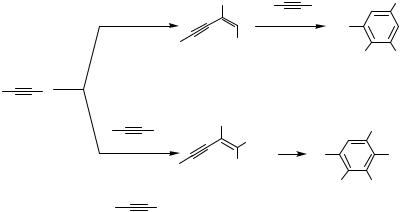
1466 |
IV Pd-CATALYZED REACTIONS INVOLVING CARBOPALLADATION |
coordination of the acceptor-substituted alkyne 3 with its lower-lying LUMO with the electron-rich acetylide (complex 12) is responsible for the observed total discrimination of the homocoupling reaction of 1 in the presence of 3 (Scheme 2).[4]
More recently, Gevorgyan and Yamamoto proposed a Pd-catalyzed trimerization of alkynes as a sequential approach to the multisubstituted benzenes 17 and 18 (Scheme 6).[7] In the first step of the sequence, a donor alkyne 1 would undergo either homodimerization to produce 2 or cross-coupling with an acceptor alkyne 3 to form an enyne 4. Enynes 2 and 4, after completion of the first step of the sequence, would undergo [4 2] benzannelation with the enynophile 16 to afford the tetraor pentasubstituted benzenes 17 and 18, respectively (Scheme 6)[7] (for the Pd-catalyzed [4 2] benzannelation of conjugated enynes, see Sect. IV.10.2).
|
|
R1 |
AG |
|
R3 |
|
R1 |
|
|
|
1 |
|
16 |
R1 |
|
|
|
|
|
R1 |
|
|
|
|
|
|
|
|
H |
|
|
|
|
|
|
|
|
2 |
|
|
AG |
|
R |
3 |
|
|
|
|
|
|
|
||
R1 |
Pd(0) |
|
|
|
48−89% |
17 |
|
|
H |
|
|
|
|
|
|
|
|
|
1 |
|
|
|
|
|
|
|
|
|
2 |
|
|
|
|
2 |
|
|
R2 |
R |
|
|
|
R |
|
|
|
EWG |
EWG |
|
|
|
|
||
|
|
3 |
16 |
R1 |
|
|
|
|
|
|
|
|
EWG |
||||
|
|
R1 |
H |
|
|
|||
|
|
|
|
|
|
|
||
|
|
4 |
|
|
AG |
R3 |
|
|
AG (Activating Group) = |
R3 |
|
|
50−61% 18 |
|
|
|
|
EWG = CO2Me, COMe |
|
|
|
|
|
|
||
|
|
|
|
|
|
|
||
Scheme 6
A brief look at Scheme 6 makes it clear that the Trost reductive coupling of alkynes[1]–[5] would be a most efficient way to produce enynes 2 and 4. While the Trost Pd(II) complex efficiently catalyzes the formation of 2 and 4 from 1 and 3, respectively, not surprisingly it was completely ineffective for the subsequent step of the sequence, which requires a Pd(0) catalyst.[8] The challenge posed by this finding was to “convince” alkynes 1 and 3 to couple with each other in the presence of a Pd(0) catalyst to produce enynes 2 and 4, which, when formed in the presence of the same catalyst, would react with the enynophile 16 in a [4 2] benzannelation fashion[8] to complete the desired sequence (Scheme 6). First, it was found that Pd(PPh3)4 catalyzed both steps of the sequence. Thus, overnight heating (12 h /100 °C) of a mixture of phenylacetylene (2 equiv), dodecadiyne (1 equiv), and Pd(PPh3)4 (5 mol %) in toluene produced the corresponding tetrasubstituted benzene 17 as a single reaction product in 89% yield. Although the reaction with these particular substrates was completely chemoselective, other alkynes reacted in a less selective way. Thus, alkyl-substituted alkynes 1 in the first stage of the sequence produced not only the homodimers 2 but also detectable amounts of the adducts with enynophile 16, which underwent benzannelation to give 5–7% of the corresponding benzene derivatives with a different set of substituents along with the major product 17; hence, the overall chemoselectivity of the sequential process was decreased.[7] This low

IV.5 ALKYNYL SUBSTITUTION VIA ALKYNYLPALLADATION |
1467 |
chemoselectivity of the alkyne dimerization was thought to be due to the rather harsh reaction conditions. A Pd2(dba)3 ( -Tol)3P system was found to be the most efficient catalyst for both steps of the sequence; 1 was homodimerized to form 2, which then underwent a subsequent [4 2] benzannelation with 16 to give benzene 17 as a single reaction product in 48–89% yield (Scheme 6). Trimerization of three different alkynes was found to require harsh reaction conditions (100 °C) in order to produce pentasubstituted benzene derivatives 18 in reasonable yields (50–61%).[7] It should be pointed out that the coupling of alkynes catalyzed by Pd(0) complexes proceeded more slowly than that in the presence of the Pd(OAc)2 TDMPP catalyst system. However, the quantitative GC analysis of the reaction mixtures at early stages confirmed that both homoand cross-coupling of alkynes proceeded cleanly and completely and the major drop in the material balance occurred during the second step of the sequence.[7] In all of the above cases, the Pd(0)-catalyzed reductive coupling of alkynes (Scheme 6)[7] follows the same stereoand regiochemical trend found in the Pd( 2)-catalyzed coupling reactions (Schemes 1– 4).[1]–[6]
Another example of Pd(0)-catalyzed dimerizations of alkynes was reported by Ishikawa and co-workers. Terminal silylacetylenes 19, containing at least one phenyl group at the silyl moiety, in the presence of Pd(PPh3)4 underwent homodimerization in a head-to-head fashion to produce the corresponding bis-silylenynes 20 in reasonable yields (Scheme 7).[9] The preferred anti-Markovnikov-type regiochemistry in these cases and also in the Pd( 2)- catalyzed homodimerization of trimethylsilylacetylene was explained with steric factors.[4]
|
|
|
|
|
Pd(PPh ) |
SiPhR2 |
|
R2PhSi |
|
|
|
3 4 |
|
R = alkyl-, Ph. |
|
|
|
|
H |
|
|
||
|
|
|
|
|
|||
|
|
|
|
|
|||
19 |
|
100 °C, 50−65% R2PhSi |
20 |
||||
|
|
|
|
|
|
Scheme 7 |
|
The following mechanism reasonably explains the Pd(0)-catalyzed coupling of alkynes (Scheme 8). The Pd(0) complex would undergo an oxidative addition of the alkyne 1 to form a Pd( 2) species 21. Coordination of the acceptor alkyne to 21 followed by migratory insertion would produce the alkenylpalladium species 22, which after reductive elimination would yield the enyne 8 and regenerate the Pd(0) catalyst (Scheme 8).
PdLn
R H
1
H
R 8
|
|
H |
|
R |
PdLn |
R |
PdLn |
21 |
H |
|
|
|
22 |
|
Scheme 8
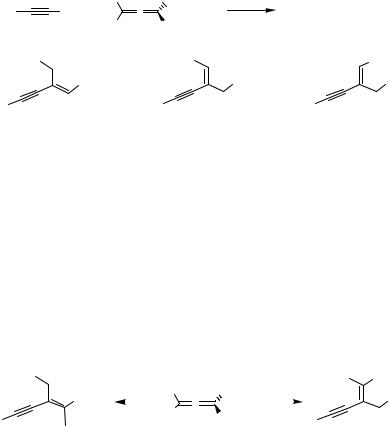
1468 |
IV Pd-CATALYZED REACTIONS INVOLVING CARBOPALLADATION |
C. ALKYNYLPALLADATION OF ALLENES FOLLOWED BY REDUCTIVE ELIMINATION
The first examples of a Pd-catalyzed addition of terminal alkynes to allenes have been reported by Trost and Kottirsch (Scheme 9).[10] They observed that different palladium complexes efficiently catalyze the addition of terminal alkynes 1 to 3-substituted allenecarboxylates 23 to produce a mixture of the , -unsaturated ester 24 and the two isomeric , -unsaturated esters (Z)- and (E)-25 (Scheme 9). Remarkably, the type of Pd catalyst used played a crucial role in determining the regiochemistry of addition to the 1,3-disubstituted allenes 23. Thus, with the Pd(OAc)2 TDMPP system (cat. A) a 76:24 ratio of 24 and (E/Z )-25 was produced, whereas with a combination of tetrakis(carbomethoxy)palladacyclopentadiene (TCPC) and TDMPP (cat. B) these products were obtained in a ratio of 9:91 (Scheme 9).[10]
R1 |
R2 |
H |
[Pd2+] |
|
H + |
|
|
|
|
|
H |
CO R3 |
|
|
|
1 |
2 |
|
|
|
23 |
|
|
|
|
R2 |
R2 |
|
R2 |
|
CO2R3 |
+ |
CO2R3 + |
CO2R3 |
R1 |
24 |
R1 |
|
R1 |
|
Z-25 |
|
E -25 |
R1 = alkyl-, Ph, TMS; R2 = Me, i-Pr; R3 = Me, Et.
Scheme 9
This observed regioselectivity difference was explained with a preferential coordination of the “electron rich TCPC catalyst” to the , -double bond of 23 versus preferential co-ordination of the less electron-rich Pd(OAc)2 TDMPP to the , -double bond of 23. In contrast to the 1,3-disubstituted allenes 23, 1,1- and 3,3-disubstituted allenes 26 showed no dependence of regioselectivity on the type of catalyst: additions to 26 always occurred onto the least sterically congested double bond leading to the exclusive formation of either , -unsaturated esters 27 or , -unsaturated esters 28 in good yields (Scheme 10).[10]
R2 |
1/[Pd2+ |
|
R2 |
R4 |
|
R2 R3 |
|
|
CO Me |
] |
1/[Pd2+] |
CO Me |
|||||
|
|
|
|
|
|
|
||
2 |
|
|
|
|
|
|
2 |
|
R1 |
|
|
|
R3 |
CO2Me |
|
R1 |
|
27 |
|
|
|
26 |
|
28 |
|
|
R1 = alkyl-, TMS; R2 = H, Me; |
|
|
|
R1 = alkyl-, TMS; |
|
|||
R3 = H; R4 = Me; 32−83%. |
|
|
|
R2 , R3 = (CH ) ; |
||||
2 5
R4 = Me; 42−81%.
Scheme 10
IV.5 ALKYNYL SUBSTITUTION VIA ALKYNYLPALLADATION |
1469 |
Alkynylpalladations of alkynes and allenes followed by reductive elimination not only represent a novel type of organic transformation but also provide synthetically useful routes toward differently substituted enynes, which are useful building blocks for the synthesis of complex organic targets including natural products and biologically important molecules.
REFERENCES
[1]B. M. Trost, C. Chan, and G. Rühter, J. Am. Chem. Soc., 1987, 109, 3486.
[2]B. M. Trost and C.-J. Li, Synthesis, 1994, 1267.
[3]B. M. Trost and M. C. McIntosh, J. Am. Chem. Soc., 1995, 117, 7255.
[4]B. M. Trost, M. T. Sorum, C. Chan, A. E. Harms, and G. Rühter, J. Am. Chem. Soc., 1997, 119, 698.
[5]B. M. Trost and M. C. McIntosh, Tetrahedron Lett., 1997, 38, 3207.
[6]B. M. Trost, S. Matsubara, and J. J. Caringi, J. Am. Chem. Soc., 1989, 111, 8745.
[7]V. Gevorgyan, U. Radhakrishnan, A. Takeda, M. Rubina, M. Rubin, and Y. Yamamoto,
J.Org. Chem., 2001, 66, 2835.
[8]V. Gevorgyan, A. Takeda, M. Homma, N. Sadayori, U. Radhakrishnan, and Y. Yamamoto,
J.Am. Chem. Soc., 1999, 121, 6391.
[9]M. Ishikawa, J. Ohshita, Y. Ito, and A. Minato, J. Organomet. Chem., 1988, 346, C58.
[10]B. M. Trost and G. Kottirsch, J. Am. Chem. Soc., 1990, 112, 2816.
